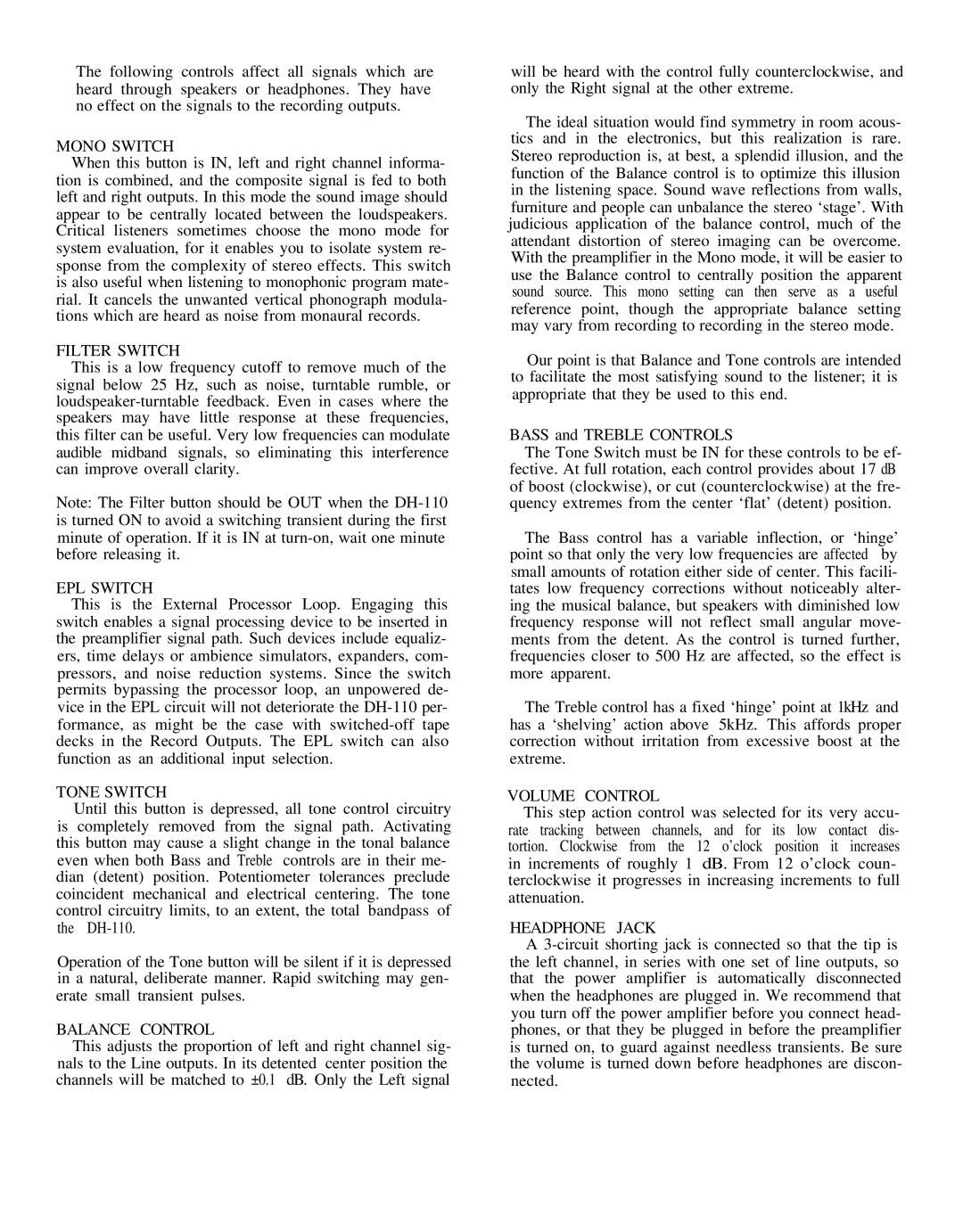The following controls affect all signals which are heard through speakers or headphones. They have no effect on the signals to the recording outputs.
MONO SWITCH
When this button is IN, left and right channel informa- tion is combined, and the composite signal is fed to both left and right outputs. In this mode the sound image should appear to be centrally located between the loudspeakers. Critical listeners sometimes choose the mono mode for system evaluation, for it enables you to isolate system re- sponse from the complexity of stereo effects. This switch is also useful when listening to monophonic program mate- rial. It cancels the unwanted vertical phonograph modula- tions which are heard as noise from monaural records.
FILTER SWITCH
This is a low frequency cutoff to remove much of the signal below 25 Hz, such as noise, turntable rumble, or loudspeaker-turntable feedback. Even in cases where the speakers may have little response at these frequencies, this filter can be useful. Very low frequencies can modulate audible midband signals, so eliminating this interference can improve overall clarity.
Note: The Filter button should be OUT when the DH-110 is turned ON to avoid a switching transient during the first minute of operation. If it is IN at turn-on, wait one minute before releasing it.
EPL SWITCH
This is the External Processor Loop. Engaging this switch enables a signal processing device to be inserted in the preamplifier signal path. Such devices include equaliz- ers, time delays or ambience simulators, expanders, com- pressors, and noise reduction systems. Since the switch permits bypassing the processor loop, an unpowered de- vice in the EPL circuit will not deteriorate the DH-110 per- formance, as might be the case with switched-off tape decks in the Record Outputs. The EPL switch can also function as an additional input selection.
TONE SWITCH
Until this button is depressed, all tone control circuitry is completely removed from the signal path. Activating this button may cause a slight change in the tonal balance even when both Bass and Treble controls are in their me- dian (detent) position. Potentiometer tolerances preclude coincident mechanical and electrical centering. The tone control circuitry limits, to an extent, the total bandpass of the DH-110.
Operation of the Tone button will be silent if it is depressed in a natural, deliberate manner. Rapid switching may gen- erate small transient pulses.
BALANCE CONTROL
This adjusts the proportion of left and right channel sig- nals to the Line outputs. In its detented center position the channels will be matched to ±0.1 dB. Only the Left signal
will be heard with the control fully counterclockwise, and only the Right signal at the other extreme.
The ideal situation would find symmetry in room acous- tics and in the electronics, but this realization is rare. Stereo reproduction is, at best, a splendid illusion, and the function of the Balance control is to optimize this illusion in the listening space. Sound wave reflections from walls, furniture and people can unbalance the stereo ‘stage’. With judicious application of the balance control, much of the attendant distortion of stereo imaging can be overcome. With the preamplifier in the Mono mode, it will be easier to use the Balance control to centrally position the apparent sound source. This mono setting can then serve as a useful reference point, though the appropriate balance setting may vary from recording to recording in the stereo mode.
Our point is that Balance and Tone controls are intended to facilitate the most satisfying sound to the listener; it is appropriate that they be used to this end.
BASS and TREBLE CONTROLS
The Tone Switch must be IN for these controls to be ef- fective. At full rotation, each control provides about 17 dB of boost (clockwise), or cut (counterclockwise) at the fre- quency extremes from the center ‘flat’ (detent) position.
The Bass control has a variable inflection, or ‘hinge’ point so that only the very low frequencies are affected by small amounts of rotation either side of center. This facili- tates low frequency corrections without noticeably alter- ing the musical balance, but speakers with diminished low frequency response will not reflect small angular move- ments from the detent. As the control is turned further, frequencies closer to 500 Hz are affected, so the effect is more apparent.
The Treble control has a fixed ‘hinge’ point at 1kHz and has a ‘shelving’ action above 5kHz. This affords proper correction without irritation from excessive boost at the extreme.
VOLUME CONTROL
This step action control was selected for its very accu- rate tracking between channels, and for its low contact dis- tortion. Clockwise from the 12 o’clock position it increases in increments of roughly 1 dB. From 12 o’clock coun- terclockwise it progresses in increasing increments to full attenuation.
HEADPHONE JACK
A 3-circuit shorting jack is connected so that the tip is the left channel, in series with one set of line outputs, so that the power amplifier is automatically disconnected when the headphones are plugged in. We recommend that you turn off the power amplifier before you connect head- phones, or that they be plugged in before the preamplifier is turned on, to guard against needless transients. Be sure the volume is turned down before headphones are discon- nected.
